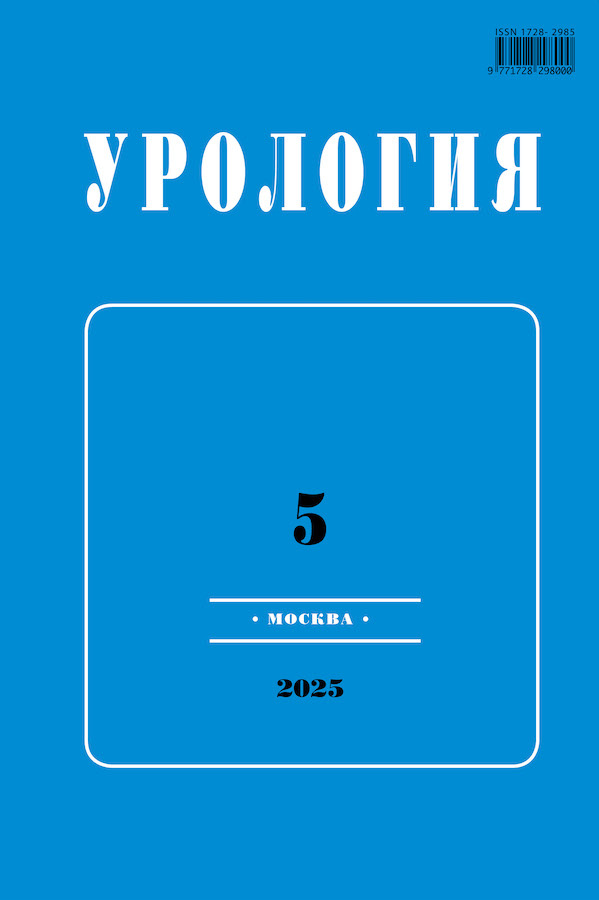Vesicovaginal fistulas: surgical strategy and rare clinical cases
- Authors: Komyakov B.K.1
-
Affiliations:
- North-Western State Medical University named after I.I. Mechnikov
- Issue: No 5 (2025)
- Pages: 113-119
- Section: Original Articles
- Published: 18.11.2025
- URL: https://journals.eco-vector.com/1728-2985/article/view/696527
- DOI: https://doi.org/10.18565/urology.2025.5.113-119
- ID: 696527
Cite item
Abstract
Aim. To present our experience of surgical management of vesicovaginal fistulas (VVFs).
Materials and methods. From 1996 to 2025, 156 women with VVFs underwent surgical treatment at the Department of Urology, North-Western State Medical University named after I.I. Mechnikov. Age ranged from 21 to 79 years (mean 45.2±4.6 years). Recurrent fistulas were observed in 42 (26.9%) patients, who had previously undergone from one to six unsuccessful surgical attempts. The predominant cause of VVF formation was iatrogenic injury to the urinary bladder during gynecological interventions (77.5%). Fistula repair was performed in 140 patients, with a transvaginal approach used in 91.4% of cases. The transabdominal approach was employed in 12 women, including 10 cases with concurrent ureteral reconstruction and 2 performed via laparoscopic approach.
Results. Among 140 patients who underwent fistula closure, success was achieved in 139 cases (99.3%).
Discussion. In our clinic, transvaginal fistula closure is the preferred surgical method for managing vesicovaginal fistulas. We consider it the least traumatic open technique, even compared with its laparoscopic alternative.
Conclusion. Transvaginal vesicovaginal fistula closure remains the method of choice for treatment of VVFs. A transabdominal approach, including laparoscopic repair, is justified only when simultaneous ureteral reconstruction is required. Heterotopic cystoplasty is regarded as the most reliable reconstructive option for patients with radiation-induced fistulas.
Full Text
About the authors
Boris K. Komyakov
North-Western State Medical University named after I.I. Mechnikov
Author for correspondence.
Email: komyakovbk@mail.ru
ORCID iD: 0000-0002-8606-9791
Ph.D., MD, professor, Head of the Department of Urology, Honoured Physician of the Russian Federation
Russian Federation, Saint PetersburgReferences
- Loran O.B., Sinyakova L.A., Seregin A.V., Tverdokhlebov N.E. Surgical treatment of patients with complex urinary fistulas. Urologiia. 2010;5:76–79. Russian (Лоран О.Б., Синякова Л.А., Серегин А.В., Твердохлебов Н.Е. Оперативное лечение больных со сложными мочевыми свищами. Урология. 2010;5:76–79).
- Female Urology, Urogynecology, and Voiding Dysfunction. Edited By S.P. Vasavada, R. Appell, P.K. Sand, S. Raz. eBook Published. 2013. P.976. https://doi.org/10.1201/b14154
- Pushkar D.Yu., Kasyan G.R. Errors and Complications in Urogynecology. Moscow: GEOTAR-Media, 2017. 384 p. ISBN 978-5-9704-4212-8. Russian (Пушкарь Д.Ю., Касян Г.Р. Ошибки и осложнения в урогинекологии. М.: ГОЭТАР-Медиа, 2017. 384 с. ISBN 978-5-9704-4212-8).
- Kan D.V. Manual of Obstetric and Gynecologic Urology. Moscow: Meditsina, 1986. 487 p. Russian (Кан Д.В. Руководство по акушерской и гинекологической урологии. М.: Медицина; 1986. 487 с.).
- Komyakov B.K. Surgical treatment of vesicovaginal fistulas: 30-year experience of the clinic. In: Proceedings of the XXIV Congress of the Russian Society of Urology. Ekaterinburg, September 12–14, 2024. P. 605. Russian (Комяков Б.К. Хирургическое лечение пузырно- влагалищных свищей: 30-летний опыт клиники. Материалы XXIIV конгресса Российского общества урологов. Сборник абстрактов. Екатеринбург, 12–14 сентября 2024. С. 605).
- Ezzat M., Ezzat M., Tran V.Q., Aboseif S.R. Repair of giant vesicovaginal fistulas. J. Urol. 2009;181:1184–1188.
- Galeev R.Kh., Galeev Sh.R., Malygin A.N. Surgical methods of vesicovaginal fistula repair. Urologiia. 2010;4:7–11. Russian (Галеев Р.Х., Галеев Ш.Р., Малыгин А.Н. Методы оперативного лечения пузырно-влагалищных свищей. Урология. 2010;4:7–11).
- Loran O.B., Seregin A.V., Dovlatov Z.A. Modern approaches to the treatment of post-radiation urogenital fistulas in women: literature review. Experimental and Clinical Urology. 2015;4:42–45. Russian (Лоран О.Б., Серегин А.В., Довлатов З.А. Современные подходы к лечению постлучевых урогенитальных свищей у женщин: oбзор литературы. Экспериментальная и клиническая урология. 2015;4:42‒45).
- Nitkin D.M. Surgical treatment of vesicovaginal fistulas. Reproductive Health. Eastern Europe. 2019;9(2):167–172. Russian (Ниткин Д.М. Хирургическое лечение пузырно-влагалищных свищей. Репродуктивное здоровье. Восточная Европа. 2019;9(2):167–172).
- Ponukalin A.N., Stativko A.V., Meylanov Sh.N. Experience in treating vesicovaginal fistulas in the clinic of SGMU. Bulletin of Medical Internet Conferences. 2019;9(2):91. Russian (Понукалин А.Н., Стативко А.В., Мейланов Ш.Н. Опыт лечения пузырно-влагалищных свищей в клинике СГМУ. Бюллетень медицинских интернет конференций. 2019;9(2):91).
- Pomeshkin E.V., Chursin V.V., Shamin M.V., Bragin-Maltsev A.I., Volokitin E.V., Popov S.V., Orlov I.N. Laparoscopic repair of vesicovaginal fistulas. Clinical Hospital. 2022;3(35):14. Russian (Помешкин Е.В., Чурсин В.В., Шамин М.В., Брагин-Мальцев А.И., Волокитин Е.В., Попов С.В., Орлов И.Н. Лапароскопическая пластика пузырно-влагалищных свищей. Клиническая больница. 2022;3(35):14).
- Suchkov D.A., Shakhaliev R.A., Shkarupa D.D., Shkarupa A.G., Kubin N.D., Gadzhiev N.K., Shulgin A.S. Vesicovaginal fistulas: modern concepts of diagnosis and treatment. Experimental and Clinical Urology. 2022;15(2):148–161. Russian (Сучков Д.А., Шахалиев Р.А., Шкарупа Д.Д., Шкарупа А.Г., Кубин Н.Д., Гаджиев Н.К., Шульгин А.С. Пузырно-влагалищные свищи: современные концепции диагностики и лечения. Экспериментальная и клиническая урология. 2022;15(2):148–161).
- Tikhonova L.V., Kasyan G.R., Pushkar D.Yu., Grigoriev N.A. Systematic review of modern Russian-language literature on urogenital fistulas in women. Urologiia. 2020;6:137–141. Russian (Тихонова Л.В., Касян Г.Р., Пушкарь Д.Ю., Григорьев Н.А. Систематический обзор современной русскоязычной литературы по урогенитальным свищам у женщин. Урология. 2020;6:137–141).
- Komyakov B.K., Fadeev V.A., Zuban O.N., Korokhodkina M.V. Reservoir-vaginal fistula is a new type of urogenital fistula. Obstetrics and Gynecology. 2007;4:49–51. Russian (Комяков Б.К., Фадеев В.А., Зубань О.Н., Короходкина М.В Резервуарно-влагалищная фистула – новый вид урогенитальных свищей. Акушерство и гинекология. 2007;4:49–51).
- Komyakov B.K., Ivanov A.O. Iatrogenic pelvic phlegmon with extensive destruction of the urinary tract. Urologiia i Nefrologiia. 1989;5:63–65. Russian (Комяков Б.К., Иванов А.О. Ятрогенная флегмона таза с обширным разрушением мочевых путей. Урология и нефрология. 1989;5:63–65).
- Komyakov B.K., Stetsik O.V., Rodygin L.M. Giant recurrent urethro-vesicovaginal fistula of 44 years’ duration with complete bladder prolapse. Urologiia. 2011;4:74–76. Russian (Комяков Б.К., Стецик О.В., Родыгин Л.М. Гигантский рецидивный уретро-пузырно-влагалищный свищ 44-летней давности с полным выпадением мочевого пузыря. Урология. 2011;4:74–76).
- Ghosh B., Wats V., Pal D.K. Comparative analysis of outcome between laparoscopic versus open surgical repair for vesico-vaginal fistula. Obstet Gynecol Sci. 2016;59(6):525‒529.
- Agrawal V., Kucherov V., Bendana E. et al. Robot-assisted Laparoscopic Repair of Vesicovaginal Fistula: A Single-center Experience. Urology. 2015;86(2):276‒281.
Supplementary files
















